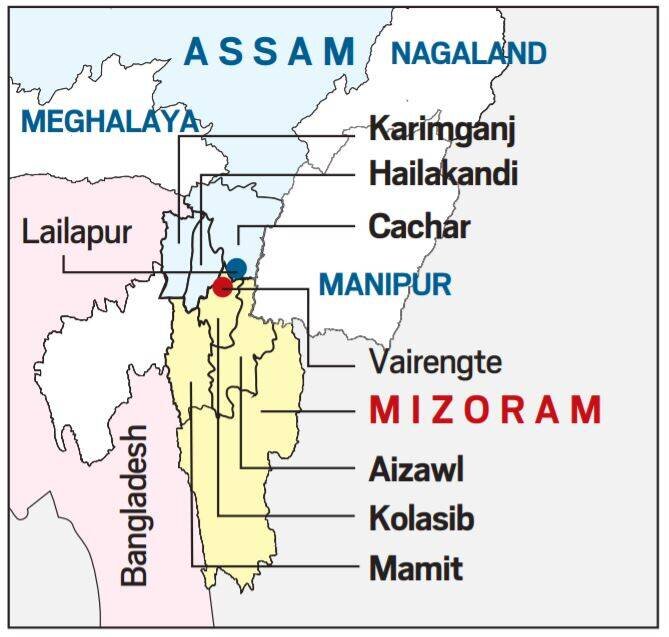Assam-Mizoram Border Dispute | 20 Oct 2020
Why in News
Recently, Assam-Mizoram border witnessed firing over a territory dispute, which spotlights the long-standing inter-state boundary issues in the Northeast, particularly between Assam and the states which were carved out of it.
- Mizoram borders Assam’s Barak Valley and the boundary between present-day Assam and Mizoram is 165 km long. Both states border Bangladesh.
Key Points
- Ongoing Tussle:
- Residents of Lailapur village in Assam’s Cachar district clashed with residents of localities near Vairengte in Mizoram’s Kolasib district.
- Earlier in October 2020, a similar clash took place on the border of Karimganj (Assam) and Mamit (Mizoram) districts.
- Mizoram civil society groups blame “illegal Bangladeshis” (alleged migrants from Bangladesh) on the Assam side.
- Background:
- The boundary issue between present-day Assam and Mizoram dates back to the colonial era when inner lines were demarcated according to the administrative needs of British Raj.
- The issue could not be settled once and for all when the state was created in independent India. The result is both states continue to have a differing perception of the border.
- Mizoram was granted statehood in 1987 by the State of Mizoram Act, 1986.
- Assam became a constituent state of India in 1950 and lost much of its territory to new states that emerged from within its borders between the early 1960s and the early 1970s.
- The Assam-Mizoram dispute stems from a notification of 1875 that differentiated Lushai Hills from the plains of Cachar, and another of 1933 that demarcates a boundary between Lushai Hills and Manipur.
- During colonial times, Mizoram was known as Lushai Hills, a district of Assam.
- Mizoram believes the boundary should be demarcated on the basis of the 1875 notification, which is derived from the Bengal Eastern Frontier Regulation (BEFR) Act, 1873.
- Mizo leaders have argued in the past against the demarcation notified in 1933 because Mizo society was not consulted.
- The Assam government follows the 1933 demarcation, and that is the point of conflict.
- According to an agreement between the governments of Assam and Mizoram, the status quo should be maintained in no man’s land in the border area.
- In the Northeast’s complex boundary equations, clashes between Assam and Mizoram residents are less frequent than they are between other neighbouring states of Assam, like with Nagaland.
- Other Boundary Issues in Northeast:
- During British rule, Assam included present-day Nagaland, Arunachal Pradesh and Meghalaya besides Mizoram, which became separate states one by one.
- Currently, Assam has boundary problems with each of them.
- Assam-Nagaland:
- Nagaland shares a 500-km boundary with Assam.
- It achieved statehood in December 1963 and was formed out of the Naga Hills district of Assam and Arunachal Pradesh (then North-East Frontier Agency).
- Violent clashes and armed conflicts, marked by killings, have occurred on the Assam-Nagaland border since 1965.
- The boundary dispute is in the Supreme Court.
- Assam-Arunachal Pradesh:
- Both states have a boundary of over 800 km.
- Arunachal Pradesh was granted statehood by the State of Arunachal Pradesh Act, 1986 in 1987.
- Clashes were first reported in 1992 and since then, there have been several accusations of illegal encroachment from both sides, and intermittent clashes.
- This boundary issue is also being heard by the Supreme Court.
- Assam-Meghalaya:
- The 884-km boundary between the two states also witnesses flare-ups.
- Meghalaya came into existence as an autonomous state within the state of Assam in April 1970 comprising the United Khasi and Jaintia Hills and the Garo Hills districts. In 1972, it got statehood.
- As per Meghalaya government statements, today there are 12 areas of dispute between the two states.

